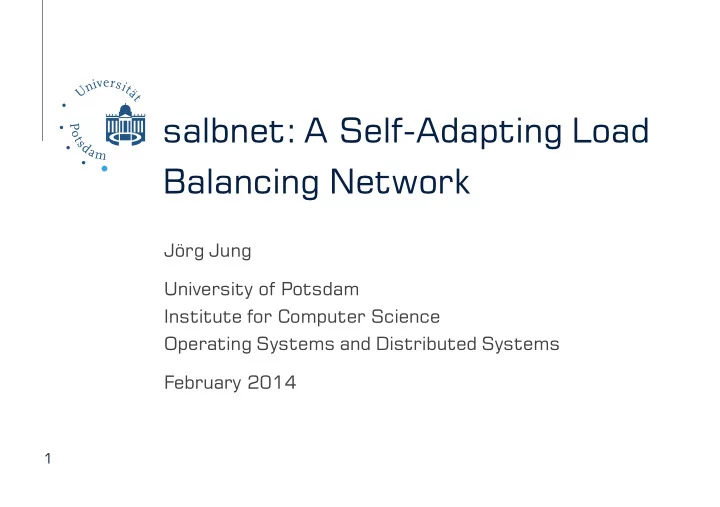

salbnet: A Self-Adapting Load Balancing Network Jörg Jung University of Potsdam Institute for Computer Science Operating Systems and Distributed Systems February 2014 1
Outline 3 1 Introduction 5 2 Credit based SLB 8 3 salbnet Implementation 10 4 Measurements and Evaluation 16 5 Conclusions and Future Work 2
1 Introduction Dispatcher based Server Load Balancing (SLB): scalable, flexible and fault tolerance services Server 1 VIP Server 2 Internet Dispatcher / Server n Load Balancer (LB) VIP 3
1 Introduction Motivation Measurements in [Zinke and Schnor 2013] show the influence of weights Sophisticated algorithms are required for heterogenous workloads and heterogenous back end servers of ISPs: Self-adapting credit based SLB algorithms for better performance Simulations in [Lehmann et al. 2008] show the advantages of the credit based SLB algorithms → Efficient implementation for credit based SLB required → Measurements to compare traditional and credit based SLB algorithms: Weighted Round Robin (WRR) and Dynamic Pressure Relieve (DPR) 4
2 Credit based SLB Application independent implicit metrics are used to calculate credits Back end server push credits to the LB Credits represent the number of connections 5
2 Credit based SLB Credit Reporting Report credits Server Ser Calculate credits Dispatcher Application Intercept Calculat system call Collect metrics R Collect Reporting Algorithms: Dynamic Pressure Relieve (DPR) and DPR-Quantize (DPR-Q) → Reporting credits based on the (amount of processed) credit metric (data) 6
2 Credit based SLB Credit Metric: TCP Backlog Application Application accept() Completed connection queue ACK complete Incomplete connection queue SYN 7
3 salbnet Implementation salbd implements metric collecting and credit reporting (runs on the LB and the back end servers) LVS scheduler module implements the credits scheduling libnetmsg implements network abstraction for sending messages over Ethernet and InfiniBand libnethook hooks into (socket) system calls in back end servers 8
3 Dispatcher Server salbd (Server) salbd (Client) httpd/named RDMA LD_PRELOAD ioctl() libnetmsg libnetmsg libnethook libnethook Shared Memory libc librdmacm librdmacm libc User space Kernel space LVS scheduler TCP/UDP TCP/UDP IP IPoIB IPoIB IP IB CM IB CM IB Verbs Verbs IB User RDMA 9
4 Measurements and Evaluation Measurements in a ISP like SLB environment: Wikipedia instance based on a dump and traces from 2007/2008 Dispatcher based SLB scenario: two armed, NAT based and using route path with heterogeneous hardware and homogeneous software versions 3 heterogenous back end servers require weights for the traditional WRR algorithm 10
4 Measurements and Evaluation Workload: Reduced Wikipedia Traces Number of requests from the first ten minutes of the (filtered and reduced) Wikipedia trace from 12. November 2007 (available from [Pierre 2010]) req ⁄ s req ⁄ s Factor Requests Mean Max 1 ⁄ 32 49,532 82.55 91 1 ⁄ 16 99,063 165.12 183 1 ⁄ 8 198,125 330.21 366 1 1,584,996 2,641.66 2,925 11
4 Measurements and Evaluation Results: (First) Response Time Factor 1 ⁄ 32 Factor 1 ⁄ 16 Factor 1 ⁄ 8 WRR DPR DPR-Q 0 0.5 1 0 0.5 1 0 0.5 1 Normalized (First) Response Time 12
4 Measurements and Evaluation Results: (Request) Errors Factor 1 ⁄ 32 Factor 1 ⁄ 16 Factor 1 ⁄ 8 WRR DPR DPR-Q 0 0.05 0.1 0 0.05 0.1 0 0.05 0.1 Normalized (Request) Error 13
4 Measurements and Evaluation Measurement Metrics (First) Response Time, (Request) Errors and Duration are combined into single lower is better penalty values SLB ISP Penalty p ISP used for comparison response max ) × ( requests total ) p ISP = ( response mean request_error mean 14
4 Measurements and Evaluation Results: SLB Penalty Factor 1 ⁄ 32 Factor 1 ⁄ 16 Factor 1 ⁄ 8 WRR DPR DPR-Q 0 0.05 0.1 0 0.05 0.1 0 0.05 0.1 SLB ISP Penalty 15
5 Conclusions and Future Work salbnet implementation for credit based SLB introduced Previous simulations are confirmed: DPR and DPR-Q outperform traditional WRR DPR-Q variant is slightly better than DPR, for higher workloads Next step: salbnet and DNS, without InfiniBand and RDMA 16
References [Lehmann et al. 2008] Janette Lehmann and Lars Schneidenbach and Bettina Schnor and Jörg Zinke. Self-Adapting Credit Based Server Load Balancing. In Helmar Burkhart, Proceedings of the IASTED international Conference on Parallel and Distributed Computing and Networks (PDCN) , pages 55–62. PDCN. ACTA Press. IASTED, Innsbruck, Austria, February 2008. ISBN: 9780889867130, ISBN CD: 9780889867147 [Pierre 2010] Guillaume Pierre. Wikipedia access tracesWikibench, October 2010. URL http://www.wikibench.eu/?page_id=60 . Accessed May 2012 17
[Zinke and Schnor 2013] Jörg Zinke and Bettina Schnor. The Impact of Weights on the Performance of Server Load Balancing Systems. In Mohammad S. Obaidat and Pere Vilà and Isaac Woungang and Mario Marchese and Floriano De Rango and Jose Saldaña, International Symposium on Performance Evaluation of Com- puter and Telecommunication Systems , pages 541–548. SPECTS 2013, Simulation Series. IEEE Communications Society. Society for Modeling & Simulation Inter- national (SCS), Toronto, Canada, July 2013. ISBN: 9781627482745 18
Recommend
More recommend